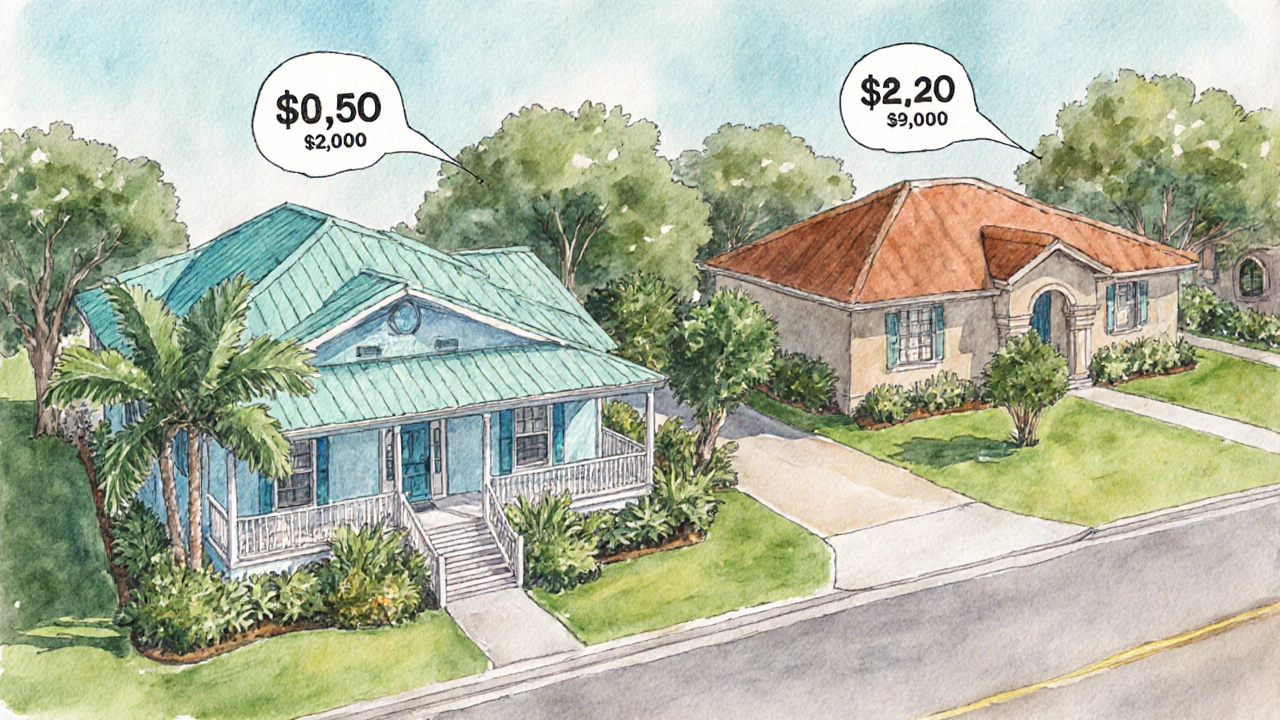Cost of Living Comparison Calculator
Your Cost of Living Calculator
Enter your current monthly expenses to see how they would compare if you moved to Florida versus Texas. Based on data from the article "Living Costs in Florida vs Texas: Which State Is Cheaper?".
Results
Florida Cost
$0Texas Cost
$0Note: These estimates are based on the cost differences mentioned in the article. Actual costs may vary based on specific locations within each state.
According to the article, Texas is typically 4-6% cheaper overall for the average household.
When you weigh moving to the Sunshine State or the Lone Star State, the first thing most people ask is: cost of living. The answer isn’t a simple yes or no - it breaks down into housing, taxes, utilities, healthcare, education, and everyday expenses. Below we unpack each piece, compare the numbers for Florida and Texas, and give you a clear picture of which state stretches your paycheck farther.
Quick Takeaways
- Housing is generally cheaper in Texas, especially outside major metros.
- Florida’s lack of state income tax is offset by higher property taxes and insurance.
- Utilities and gasoline are slightly lower in Texas.
- Healthcare costs favor Texas, while education expenses are comparable.
- Overall, Texas edges out Florida by about 4‑6% in total cost of living.
Defining the Cost‑of‑Living Landscape
Cost of living is a composite index that measures how much money is needed to maintain a standard of living in a given area. It includes housing, food, transportation, healthcare, taxes, and other routine expenses. The index is expressed relative to a baseline city - often New York City = 100 - so a score of 80 means you need 20% less money than in New York.
Florida is a southeastern U.S. state known for its warm climate, tourism‑driven economy, and no state income tax. Its major metros are Miami, Orlando, Tampa, and Jacksonville.
Texas spans the south‑central U.S., boasting a diverse economy from oil to tech. Key cities include Houston, Dallas, Austin, and San Antonio. Like Florida, Texas also has no state income tax.
Housing: The Biggest Driver
Housing typically accounts for 30‑35% of the overall cost‑of‑living index. In 2025, the median home price in Florida sits around $380,000, while Texas averages $310,000. However, regional variance matters. Miami’s median hits $460,000; Dallas hovers near $340,000.
Median home price reflects the middle value of all residential sales in a given market. It’s a quick proxy for housing affordability.
Rent follows a similar pattern. A two‑bedroom apartment in Tampa costs roughly $1,500 per month versus $1,300 in Houston. Rural areas in both states can dip below $1,000, but Texas’s smaller urban cores keep rents lower overall.
Taxes: Income, Property, and Sales
Both states brag about zero state income tax, which can shave 4‑5% off a typical household’s tax bill compared to states like California. Property tax, however, tilts the scales.
Property tax is a yearly levy on real‑estate value, expressed as a percentage. In Florida, the average effective property tax rate is 0.98%, while Texas sits at 1.81% - one of the highest in the nation. The higher rate in Texas is mitigated by lower home values.
Sales tax also differs: Florida’s statewide rate is 6%, with local add‑ons raising it to 7.5% in most areas. Texas charges a 6.25% base rate, but local jurisdictions can push it to 8.25%.
Utilities and Energy
Utility bills in Texas benefit from a deregulated electricity market, meaning consumers can shop for cheaper plans. The average monthly electricity cost in Texas is about $115, compared to $130 in Florida.
Natural gas usage is higher in Texas’s colder winters, but overall energy costs remain 5‑7% lower than Florida’s, where air‑conditioning dominates summer usage.

Transportation: Gas, Insurance, and Public Transit
Both states rely heavily on personal vehicles. Gasoline prices in Texas average $2.55 per gallon, while Florida hovers around $2.85. Car insurance premiums are slightly higher in Florida due to its “no‑fault” insurance system - around $2,150 annually versus $1,800 in Texas.
Public transit options are limited in both states, but major metros like Miami and Dallas offer light rail and bus networks that can reduce costs for commuters.
Healthcare and Education Costs
Healthcare spending per capita in Texas is roughly $6,200, while Florida’s is $6,800, driven by higher insurance premiums and a larger elderly population. Out‑of‑pocket expenses follow the same trend.
Education expenses - from K‑12 tuition to college tuition - are comparable. Public K‑12 schools are funded primarily by local property taxes, so the higher tax rate in Texas can translate into better-funded districts in some areas, though outcomes vary.
Everyday Expenses: Food, Clothing, and Entertainment
The Grocery Index (a component of the cost‑of‑living calculator) rates Texas at 95 and Florida at 98, indicating slightly cheaper groceries in Texas. Dining out follows the same pattern - a meal for two at a mid‑range restaurant costs about $55 in Texas versus $60 in Florida.
Clothing and personal care items show negligible differences, usually within 2%.
Side‑by‑Side Comparison Table
| Category | Florida | Texas |
|---|---|---|
| Median Home Price | $380,000 | $310,000 |
| Average Rent (2‑BR) | $1,500/mo | $1,300/mo |
| Property Tax Rate | 0.98% | 1.81% |
| Sales Tax (max) | 7.5% | 8.25% |
| Electricity Cost | $130/mo | $115/mo |
| Gasoline (per gal) | $2.85 | $2.55 |
| Car Insurance | $2,150/yr | $1,800/yr |
| Healthcare per Capita | $6,800 | $6,200 |
| Grocery Index | 98 | 95 |
| Restaurant (2‑person Meal) | $60 | $55 |

Putting the Numbers in Perspective
Summing up the major categories, Texas scores roughly 4‑6% lower on the overall cost‑of‑living index. The biggest savings come from housing and energy. Florida’s advantage lies in a slightly lower sales‑tax burden and, for retirees, a favorable homestead exemption that can reduce property taxes for primary residences.
If you’re a young professional earning $75,000 a year, the extra $5,000‑$7,000 in disposable income you’d get in Texas could fund a down‑payment, a car, or more vacation days. Retirees on a fixed income might appreciate Florida’s tax-friendly stint and its higher concentration of senior services, even if day‑to‑day expenses run a bit higher.
How to Choose the Right State for You
- Budget focus: If housing costs dominate your budget, Texas offers clearer wins, especially in suburbs.
- Climate preference: Florida provides year‑round warmth but also hurricane risk; Texas has hotter summers and occasional winter chills.
- Healthcare needs: Texas’s lower per‑capita spending can translate into cheaper premiums, but Florida’s large senior‑care network may offer more specialized services.
- Career sector: Tech and aerospace thrive in Austin and Houston; tourism and maritime industries favor Florida’s coastal cities.
- Family considerations: Look at school district ratings, which often correlate with local property tax revenue.
Actionable Checklist for Relocators
- Calculate your current cost‑of‑living breakdown (housing, tax, utilities, etc.).
- Use an online calculator (e.g., Numbeo, NerdWallet) to input Florida and Texas city data.
- Factor in moving costs - average long‑distance move is $4,000‑$6,000.
- Research state‑specific incentives: Texas offers property tax abatements for first‑time homebuyers; Florida provides homestead exemptions up to $50,000.
- Visit both states (if possible) for a week‑long stay to gauge lifestyle fit.
- Consult a local realtor familiar with land parcels if you’re buying land outright.
- Finalize budget, secure employment or remote work arrangements, and lock in housing before the peak moving season (May‑July).
Frequently Asked Questions
Which state has cheaper property taxes?
Florida’s effective property tax rate (0.98%) is lower than Texas’s 1.81%, but because Texas homes often cost less, the dollar amount of taxes paid can be similar or even lower in Texas.
Does the lack of state income tax make both states equally affordable?
No. While both states eliminate the state income tax, other factors - especially housing, insurance, and utilities - create a noticeable cost gap that generally favors Texas.
How do hurricane risks affect living costs in Florida?
Hurricane‑prone counties often require higher home‑owner’s insurance (up to $5,000 extra per year) and stricter building codes, which can raise both purchase price and ongoing costs.
Is Texas’s higher sales tax a deal‑breaker?
Most Texas cities levy the maximum 8.25% sales tax, but because groceries and many essential items are exempt, the impact on day‑to‑day expenses is modest compared with housing savings.
Which state offers better incentives for buying land?
Texas often provides property tax abatements for new developments and has fewer zoning restrictions, making it attractive for land investors. Florida offers homestead exemptions that lower property tax for primary residences but can be less flexible for raw land purchases.
Final Thought
Choosing between Florida and Texas isn’t just a numbers game; it’s about aligning costs with your lifestyle, career, and long‑term goals. If raw affordability and energy savings matter most, Texas nudges ahead. If you value a warm climate, no‑income‑tax boost, and a mature senior‑care ecosystem, Florida still holds strong appeal. Use the data, run your personal calculator, and you’ll land on the state that feels like home both financially and personally.
